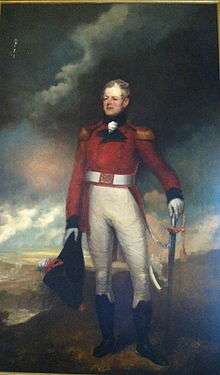Robert Field (painter)

Robert Field (1769–1819) was a painter who was born in London, England, and died in Kingston, Jamaica. He was one of America’s leading miniaturists. Along with being the most important painter in Nova Scotia at the beginning of the 19th century,[1] at this time, Field was probably the most professionally trained painter to settle in Canada. Daphne Foskett in A Dictionary of British Miniature Painters (1972) wrote that Field was, "one of the best American miniaturists of his time." He worked in the conventional neo-classic portrait style of Henry Raeburn and Gilbert Stuart.[2] His most famous works are two groups of miniatures of George Washington, commissioned by his wife Martha Washington. (Field's miniatures of both are in the Yale University Art Gallery permanent collection.)
America
He received his early training at the Royal Academy schools, London, in 1790. In 1794 he moved to the United States. He took up residence in the nation's then-capital, Philadelphia, Pa. There he immediately joined a group of artists led by Charles Willson Peale in establishing the Columbianum, or American Academy of the Fine Arts, which was eventually superseded by the Pennsylvania Academy of the Fine Arts in 1805.
Field spent 14 years in the United States, working as a miniature painter in Baltimore, Philadelphia, Washington, and Boston; during this period he produced miniatures of George and Martha Washington, Thomas Jefferson, and a wide range of people prominent in the social, economic, and political life of American society.[2] According to historian Harry Piers, Field was one of the four most highly sought American miniaturists in his time. Martha Washington herself commissioned Field in 1800 to paint a group of miniature as mementoes for friends and family, to commemorate the revered General and President on the one-year anniversary of his death. Two groups of miniatures of George Washington were produced by Field at Martha's request in late 1800, the first group showing him in civilian dress, the second as general in full uniform.[3]
Nova Scotia
When tensions between America and England started to rise in the lead up to the War of 1812, Field remained a loyalist and moved from Boston to Halifax, Nova Scotia (1808). He continued to produce miniatures, but he also painted more than 50 oil portraits of government officials, military officers, merchants, and assorted members of the Halifax "gentility"; among his subjects were Bishop Charles Inglis, former lieutenant governor Sir John Wentworth, Sir George Prevost, Sir John Coape Sherbrooke, Admiral of the Fleet Sir Provo William Parry Wallis, and Sir Alexander Forrester Inglis Cochrane, vice-admiral in the Royal Navy (whose portrait was shown at the Royal Academy exhibition in London in 1810).[2]
Jamaica
In 1816 he moved to Jamaica, settling first in Montego Bay and then in Kingston. He died on 9 August 1819, apparently of yellow fever, and was buried in an unmarked grave in the old "West Ground" cemetery, now called the Strangers' Burial Ground, near the Kingston parish church.[2]
Gallery
 American President Thomas Jefferson
American President Thomas Jefferson Richard John Uniacke (1811)
Richard John Uniacke (1811)



_by_RobertField%2C_Government_House_Nova_Scotia.jpg) Matthew Richardson (merchant) , (Government House (Nova Scotia)
Matthew Richardson (merchant) , (Government House (Nova Scotia)

 Rev Archibald Gray
Rev Archibald Gray.png) Admiral Sir Alexander Cochrane
Admiral Sir Alexander Cochrane
Other works
- Brewer John Lewis, National Portrait Gallery, London - founder of Richmond Park [4]
- Mrs. George Washington
- John Merrick (architect), (Province House)
- Sir Alexander Cochrane[5]
- Sir Edward Parry
- Commissioner John Nicholson Inglefield
- Hon. Michael Wallace
- Hon. Lawrence Hartshorne
- Hon. Charles Morris, 3rd
- Adam DeChezeau
- Rev. Dr. Archibald Gray and Mrs. Gray
- Andrew Wrightand sister Mary
- Dr. William J. Almon
- Hon. James Fraser
- Judge James Stewart
- Sir John Wentworth, 1st Baronet
- Dr. John Halliburton
- Charles Geddes
- John Bremner
- Captain Thomas Maynard, R. N.
- Rear Admiral Herbert Sawyer
- Hon. William Lawson (banker) (Bank of Nova Scotia)
- Dr. Joseph Prescott
- Dr. Mather Byles
- Captain Nicholas Thomas Hill
References
Endnotes
- ↑ http://www.biographi.ca/EN/EN/009004-119.01-e.php?id_nbr=3705
- 1 2 3 4 Robert Field – Dictionary of Canadian Biography Online
- ↑ Piers, Harry, Robert Field: Portrait Painter in Oils, Miniature and Water-Colours and Engraver, New York, 1927.
- ↑ http://www.richmond.gov.uk/john_lewis_brief_open.pdf
- ↑ National Gallery
- Robert Field, Art Gallery of Nova Scotia 1978
Texts
- Harry Piers. Artists of Nova Scotia. Nova Scotia Historical Society. 1914. p. 112- 119
- Early American portrait painters in miniature by Theodore Bolton. New York. 1921 - Robert Field
- Piers, Harry, Robert Field: Portrait Painter in Oils, Miniature and Water-Colours and Engraver, New York, 1927.
External links
| Wikimedia Commons has media related to Robert Field (painter). |